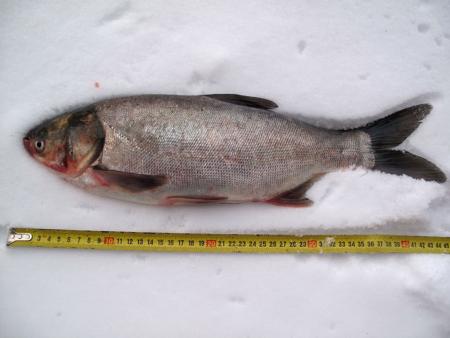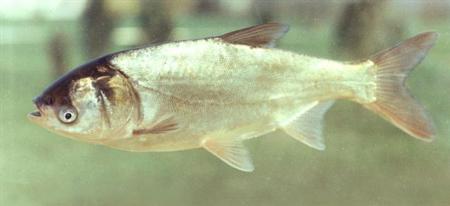Silver Carp
-
Scientific Name
Hypophthalmichthys molitrix. Visit ITIS for full scientific classification.
-
Description
 Silver Carp. Photo by Dezidor (commons.wikimedia.org)
Silver Carp. Photo by Dezidor (commons.wikimedia.org) Silver Carp. Photo by Harka Akos (commons.wikimedia.org)
Silver Carp. Photo by Harka Akos (commons.wikimedia.org)- Large, freshwater fish with an elongated body shape. They have a scale-less head with low hanging, and slightly downward facing eyes.
- They have a large mouth with no teeth in the jaw, but do have teeth in their throat.
- They are a gray to olive green color on their backs, with a silvery color on their sides.
- Silver Carp feed on plankton, using their modified gills to filter their food from the water column.
- Possible for individuals to grow over 4 feet, and up to 77 pounds.
-
Habitat
- Found in shallow, flooded areas of rivers, ponds, irrigation canals, lakes, and reservoirs.
- Bighead Carp can tolerate extreme environmental conditions including: low oxygen levels, brackish water, and temperatures ranging from 32-104 degrees F.
-
Invasion Pathways and Distribution
- In 1973, Silver Carp were introduced into a variety of different water bodies in Arkansas in order to control phytoplankton populations.
- Asian Carp can spread through fish farming activities, legal and illegal stocking, accidental inclusion in shipments of live bait, escape or release to open waters, and natural dispersal.
- Native to China and Russia.
- Now widespread throughout the U.S.
- See USGS for a map of current U.S. distribution.
-
Life History
- Mating season begins in the summer when the water is warmer than 65 degrees F.
- Females migrate to areas of moderate water flow in order to release their eggs into the water column.
- Enormous reproductive capabilities.
- Possible for females to release over 1 million eggs in a single season.
-
Impacts
- Due to their ability to filter feed and grow to a large size, Silver Carp can greatly reduce the amount of plankton in their surrounding environment.
- This plankton reduction can decrease food availability for native species, possibly reduce water quality, and increase the chance for algal blooms.
- Silver Carp also carry diseases that can then spread to native fishes.
-
References and Useful Links
For references by category and links to other useful AIS sites see our LEARN MORE page.


